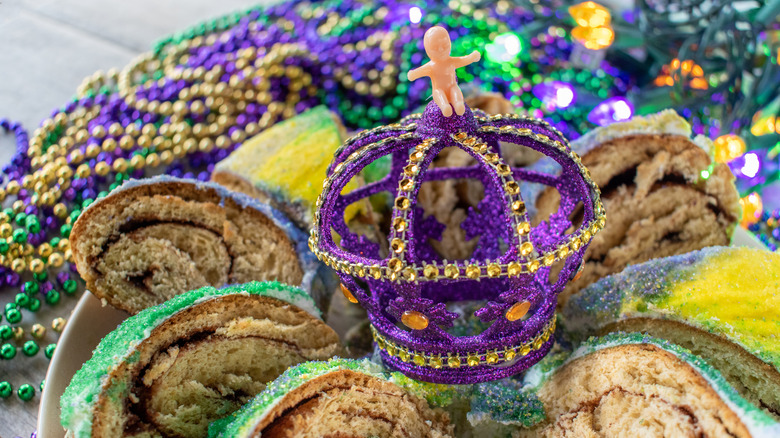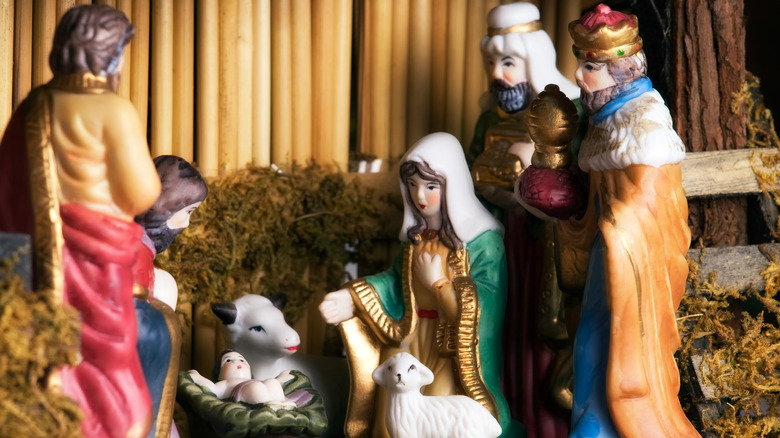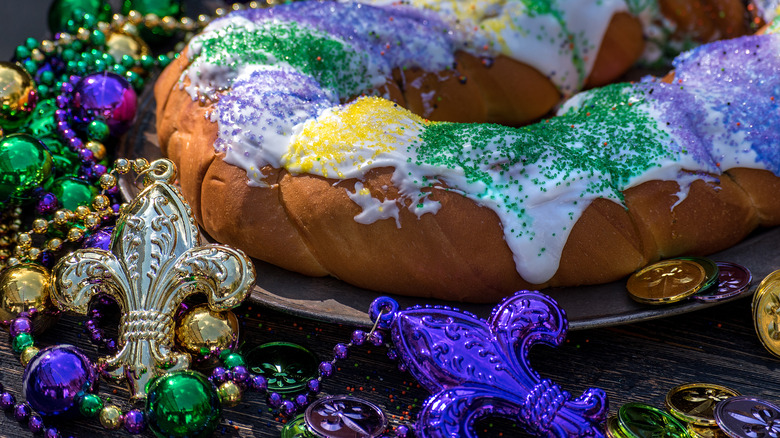Why People Hide Plastic Babies In Mardi Gras Cakes
On the last day of Carnival comes vibrant Mardi Gras — French for "Fat Tuesday." The Carnival celebrations stretch to Ash Wednesday, where the final Tuesday within that period is the last day for luxuries before the Lenten abstinence.
And on Mardi Gras, what could feel richer than eating the flamboyantly titled King Cake? Sprinkled with the celebration's iconic gold, green, and purple hues, these cakes often have, hidden inside, a small plastic baby figurine. Of course, because baking plastic inside food may not appeal to everyone, the baby figurine is often pressed into the cake just before it is served.
In either case, getting the cake slice that contains the baby signals that the receiver will have good fortune. They must also arrange the King Cake for the following year's celebration. The plastic baby in the Mardi Gras cake holds special significance, that goes back to the arrival of the three kings in Bethlehem who came bearing gifts for baby Jesus. Dig a little deeper, however, and one finds that the story has multiple layers. The practice of hiding plastic babies in cakes evolved due to celebratory traditions and, quite possibly, the business smarts of one traveling salesman.
The plastic babies signify baby Jesus
The tradition of Mardi Gras came to the U.S. from Europe (likely France or Spain) and was enthusiastically adopted in New Orleans, which continues to be the hub of the celebration. The significance of the figurine in the cake as baby Jesus is widely accepted. However, New Orleans lore traces the doll-in-cake to hiding a bean or ring in the elaborate festive cake during the King's ball celebrations in colonial Lousiana during the 19th century.
Whoever found the prize hidden in the cake was crowned King or Queen of the ball, which would take place in the days leading up to Mardi Gras. According to some historians, the practice was started by a New Orleans social group, the Twelfth Night Revelers, who hosted the season's first ball. The switch from bean and ring to baby figurines occurred around the mid-1900s, according to New Orleans food expert Poppy Tooker (via NPR).
While King Cakes were traditionally homemade cakes eaten with the family, the burgeoning popularity of Mardi Gras celebrations led to more and more revelers turning to commercial bakeries for their cakes. A traveling salesman with a surplus of French porcelain figurines approached the owner of McKenzie's, a popular bakery, with the idea of baking the tiny dolls into cakes. It worked, and once the French figurines ran out, the baker resorted to sourcing baby figurines from the city's French Quarter, starting the Mardi Gras trend we all know today.
A brief history of King Cake
The festive Mardi Gras cakes are a well-traveled tradition from Colonial Europe that has since been localized. In the US, the ring-shaped cake is decorated with Mardi Gras colors — gold for power, green for faith, and purple for justice. These are also thought to be the House colors of Grand Duke Alexis, the first Russian royal to visit the U.S., who came to New Orleans during Mardi Gras in 1872 and was welcomed by crowds holding strings of gold, green, and purple beads.
The frosted, ring-shaped cake, filled with cream cheese, chocolate, cinnamon, and fruit, first appears on January 6th (also called Epiphany or Three Kings Day) and continues to be served before Ash Wednesday. Some even say that the cake's shape is meant to resemble a king's crown.
Interestingly, King Cake was originally a fixture of Epiphany, not the entire season, and until the 1950s, people ate donuts on Mardi Gras. However, with the increasing popularity of King Cake, its availability spread to the entire Carnival season. The fact that they replaced donuts may have something to do with why King Cakes in the Big Easy are often fried, giving them a distinctive texture.
Other places that embraced Mardi Gras celebrations have versions of King Cake, like Mexico's Rosca de Reyes, a sweet bread topped with candied fruit. Of course, some aspects remain fixed, like the cake's shape and the tradition of hiding a lucky trinket within.


